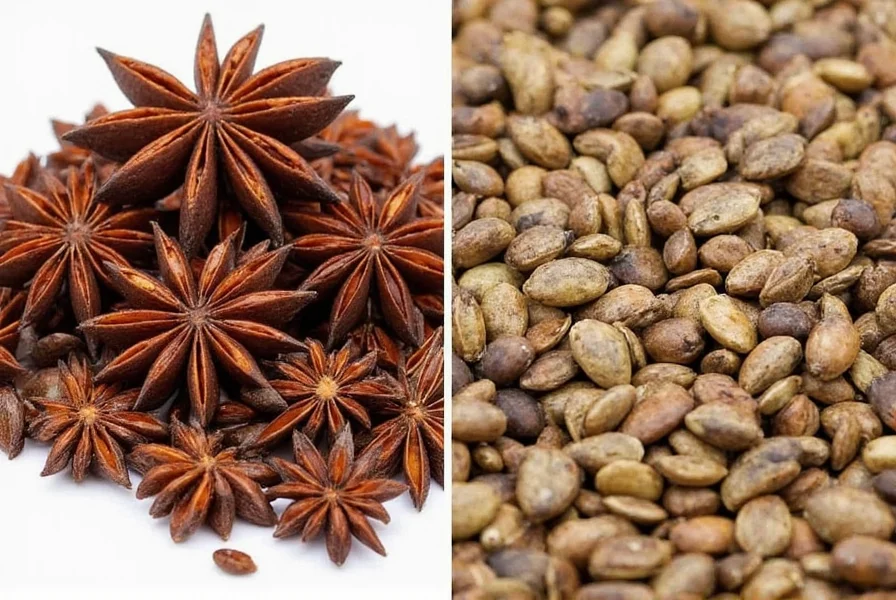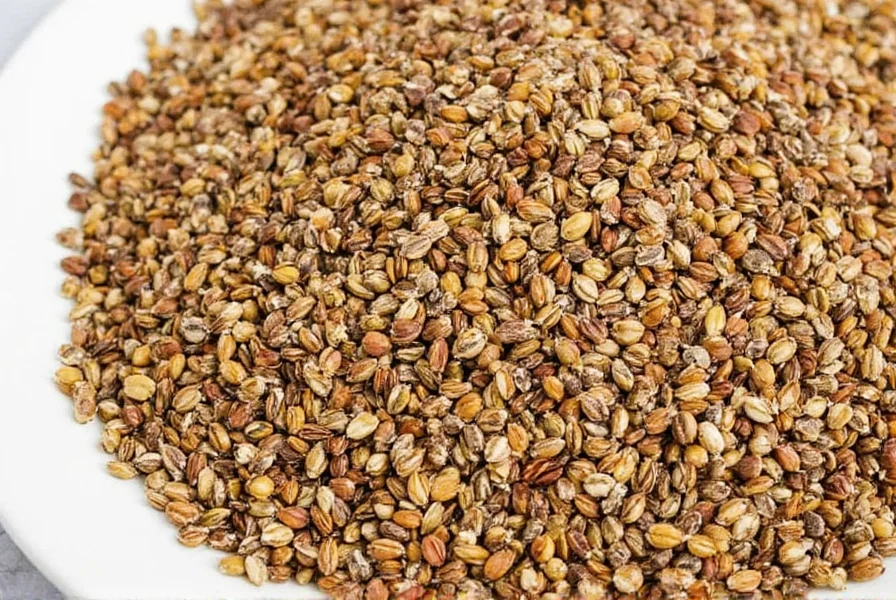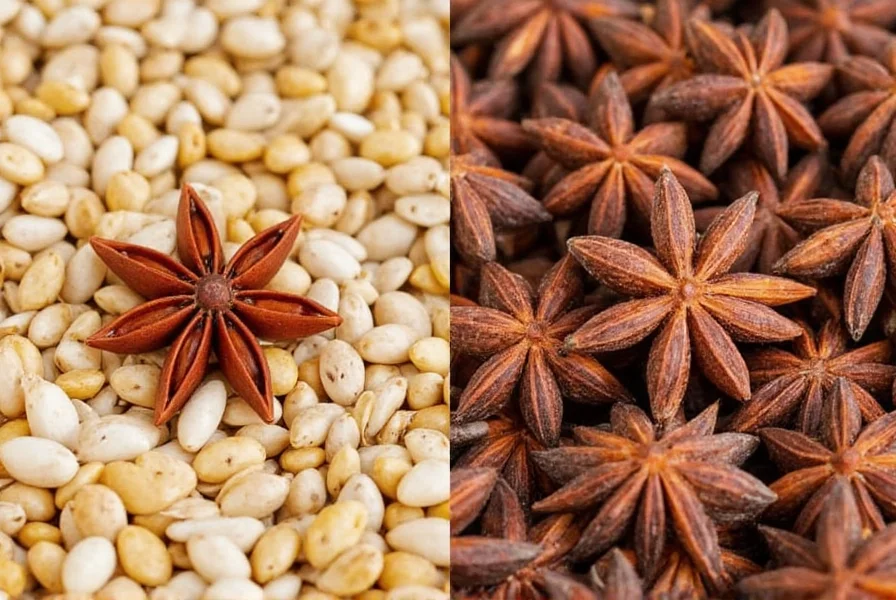Understanding the difference between star anise and anise seed is essential for home cooks and professional chefs alike. These two spices often cause confusion due to their similar names and shared anethole compound that creates that distinctive licorice taste. However, substituting one for the other without understanding their unique properties can dramatically alter your dish's flavor profile.
Botanical Origins and Physical Characteristics
Star anise grows on Illicium verum, an evergreen tree native to southwest China and Vietnam. The spice consists of the star-shaped fruit pods, typically with 6-8 points, each containing a single seed. These pods measure about 1-2 inches across and transition from green to rust-brown as they mature. The entire pod is used in cooking, though sometimes the seeds are extracted.
In contrast, anise seed comes from Pimpinella anisum, an annual herb in the Apiaceae family (which includes parsley, carrots, and dill). The plant grows to about 2 feet tall and produces small white flowers that develop into crescent-shaped seeds approximately 1/8 inch long. These seeds have a smooth, grayish-brown surface with fine ridges running their length.
| Characteristic | Star Anise | Anise Seed |
|---|---|---|
| Botanical Name | Illicium verum | Pimpinella anisum |
| Plant Type | Evergreen tree | Annual herb |
| Native Region | China, Vietnam | Mediterranean |
| Physical Form | Star-shaped fruit pod (1-2 inches) | Small crescent seeds (1/8 inch) |
| Primary Flavor Compound | Anethole (90% of essential oil) | Anethole (80-90% of essential oil) |
Flavor Profile Comparison
While both spices share that characteristic licorice note due to anethole, their flavor profiles differ in important ways. Star anise delivers a more intense, slightly sweeter, and more complex flavor with subtle notes of citrus and spice. Its flavor is robust enough to stand up to long cooking times, making it ideal for braises, stews, and slow-cooked dishes.
Anise seed offers a more delicate, sweeter, and somewhat floral licorice flavor with subtle hints of fennel. The flavor is more immediate but less enduring than star anise, which is why it works better in quick-cooking applications and baked goods. When comparing star anise vs anise seed in baking, the seed's more subtle flavor often integrates better with other ingredients.

Culinary Applications and Substitution Guide
Understanding when to use each spice can elevate your cooking. Star anise shines in Asian cuisine—particularly Chinese five-spice powder, Vietnamese pho broth, and Indian garam masala. Its robust flavor withstands long cooking times, making it perfect for meat braises, mulled wines, and chai tea. One whole star anise pod equals approximately 1 teaspoon of crushed star anise.
Anise seed features prominently in Mediterranean and Middle Eastern cooking. Bakers use it in biscotti, black and white cookies, and German pfeffernüsse. It also appears in sausages, fish dishes, and some cheese preparations. When comparing star anise vs anise seed for baking applications, the seed generally provides a more balanced flavor that doesn't overwhelm other ingredients.
Substitution guidance: You can substitute one for the other, but with important caveats. One star anise pod equals about 1/2 teaspoon of anise seed. Because star anise is more potent, use less when substituting. For dishes requiring whole spices (like braises), star anise works better than anise seed, which may become bitter when cooked too long. For baking and quick applications, anise seed generally provides a more balanced flavor.
Nutritional and Potential Health Benefits
Both spices contain beneficial compounds, though their nutritional profiles differ. Star anise is particularly rich in shikimic acid, the key ingredient in Tamiflu, and contains significant amounts of linalool and limonene. It has been traditionally used to support digestion and respiratory health.
Anise seed contains higher levels of certain minerals like iron and manganese, and has been studied for potential estrogenic effects. Both spices demonstrate antioxidant properties, though star anise generally shows higher antioxidant capacity in scientific studies.
When considering star anise vs anise seed for health benefits, note that Japanese star anise (Illicium anisatum) is toxic and should never be consumed. Always ensure you're using Chinese star anise (Illicium verum) from reputable sources.
Storage Recommendations and Shelf Life
Proper storage preserves the flavor compounds in both spices. Store whole star anise pods in an airtight container away from light and heat—they maintain peak flavor for 2-3 years. Ground star anise loses potency more quickly, lasting only 6-12 months.
Anise seeds retain their flavor best when stored whole. Keep them in a cool, dark place in an airtight container where they'll stay fresh for 1-2 years. Ground anise seed deteriorates faster, with optimal flavor lasting only 3-6 months. For maximum flavor in dishes comparing star anise vs anise seed, always toast whole spices briefly before use to release their essential oils.
Common Misconceptions Clarified
Several myths persist about these spices. First, star anise and anise seed are not interchangeable in equal amounts—star anise is significantly more potent. Second, despite the similar names, they're not related botanically. Third, neither spice contains actual anise alcohol (anisette)—the flavor similarity comes from the shared anethole compound.
Another common confusion involves star anise vs anise seed in relation to fennel and licorice root. While all share licorice notes, fennel seed comes from a different plant (Foeniculum vulgare) and has a milder, sweeter profile, while licorice root (Glycyrrhiza glabra) delivers a much stronger, sweeter flavor with different chemical properties.

Practical Usage Tips
For the best results when working with these spices, consider these professional tips:
- Use whole star anise in liquid-based dishes (soups, stews, poaching liquids) and remove before serving
- Grind anise seed fresh for baking applications to maximize flavor impact
- When making homemade extracts, star anise creates a more robust vanilla-almond flavor profile
- For tea blends, use 1 star anise pod per 8 ounces of water or 1/4 teaspoon crushed anise seed
- Combine star anise with cinnamon and cloves for authentic Chinese red cooking
Understanding the nuanced differences between star anise and anise seed transforms your cooking from good to exceptional. While they share that beloved licorice note, recognizing when to reach for each spice ensures your dishes achieve authentic flavor profiles whether you're preparing Vietnamese pho, Italian biscotti, or Indian biryani.
Frequently Asked Questions
Can I substitute star anise for anise seed in baking?
Yes, but with caution. Use 1/2 teaspoon of crushed star anise for every teaspoon of anise seed called for in baking recipes. Star anise has a stronger, more complex flavor that can overwhelm delicate baked goods if used in equal amounts. For best results, toast and grind whole star anise just before using.
Which spice is stronger, star anise or anise seed?
Star anise is significantly stronger than anise seed. It contains a higher concentration of anethole (90% of its essential oil versus 80-90% in anise seed) and delivers a more intense, complex flavor with additional citrus and spice notes. When substituting, use approximately half the amount of star anise compared to anise seed.
Is star anise the same as Chinese five-spice?
No, star anise is just one component of Chinese five-spice powder, which typically contains star anise, cloves, Chinese cinnamon, Sichuan pepper, and fennel seeds. Star anise provides the dominant licorice note in this blend, but the other spices create a more complex flavor profile essential to many Chinese dishes.
Can you eat star anise whole?
While star anise pods are technically edible, their tough, woody texture makes them unpleasant to chew. Chefs typically add whole pods to liquid-based dishes during cooking and remove them before serving. The seeds inside the pods are edible and contain concentrated flavor, but most recipes call for using the entire pod for even flavor distribution.
Why does my star anise taste bitter?
Bitter star anise usually indicates one of three issues: it's old and stale (whole star anise keeps flavor for 2-3 years), it's been overcooked (especially in dry applications), or it's actually Japanese star anise (Illicium anisatum), which is toxic and extremely bitter. Always purchase star anise from reputable sources and store it properly in an airtight container away from light and heat.











 浙公网安备
33010002000092号
浙公网安备
33010002000092号 浙B2-20120091-4
浙B2-20120091-4